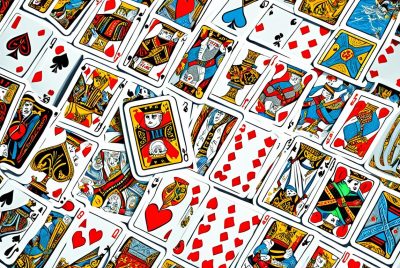Supplementing Missing Suits in Card Game Decks: Pros and Cons
Have you ever found yourself in the middle of an intense card game, only to discover that a suit is missing from the deck? It’s a frustrating situation that can throw off your entire game strategy. But fear not, because there are solutions available to restore the missing suit and get your game back on track.
From suit replacement options to suit repair services, there are various ways to address the issue of a missing suit in your card game deck. But what are the pros and cons of supplementing missing suits? Does it really improve your game or does it alter the dynamics in unfavorable ways?
Key Takeaways:
- Supplementing missing suits in card game decks can enhance the overall gameplay experience.
- It provides an opportunity for improved bidding strategy and trick-taking potential.
- However, it may also change the gameplay dynamics, creating unpredictability.
- Supplementing missing suits can limit strategic options and reduce the challenge in playing the game.
- Consider the pros and cons before deciding to supplement missing suits in your card game deck.
Evaluating Hand Strength with High Card Points (HCP)
In the game of Contract Bridge, evaluating the strength of a hand is crucial for determining the optimal bidding strategy. One widely used method for hand evaluation is the basic point-count system, which assigns numeric values to high card points (HCP). The HCP count is based on the strength of honor cards like the ace, king, queen, and jack. By summing up the HCP value of a hand, players can assess its overall strength.
However, it’s essential to recognize that relying solely on the HCP count may not always provide an accurate reflection of a hand’s trick-taking potential. Other factors such as suit distribution, control cards, and the fit with the partner’s hand also play significant roles in evaluating hand strength.
Suit Distribution: The distribution of suits in a hand can greatly impact its potential to win tricks. For example, a hand with long suits (containing many cards in a particular suit) can be advantageous as it provides more opportunities for establishing more tricks. On the other hand, a hand with short suits (void, singleton, or doubleton) may present challenges in maintaining control over certain suits.
Control Cards: Control cards refer to high-ranking cards, particularly aces and kings, in a particular suit. These control cards enable players to gain control over a given suit and prevent opponents from winning tricks. The presence of control cards can significantly enhance the trick-taking potential of a hand.
Hand Evaluation Example:
To illustrate the importance of considering factors beyond HCP, let’s look at an example hand:
| Suit | HCP | Suit Distribution | Control Cards |
|---|---|---|---|
| Spades | 1 | Singleton | Ace |
| Hearts | 8 | Long | Ace, King |
| Diamonds | 3 | Void | – |
| Clubs | 8 | Doubleton | King |
In this example, the hand has a total HCP count of 20. However, looking beyond the HCP count, we can observe that the hand has a singleton spade, a long suit in hearts, a void in diamonds, and a doubleton in clubs. These suit distributions and the presence of control cards (ace in spades, ace and king in hearts, king in clubs) significantly enhance the hand’s trick-taking potential.

By considering the HCP count, suit distribution, and control cards, players can make a more accurate evaluation of their hand’s strength and strategically plan their bidding and gameplay accordingly.
Supplementing Missing Suits with Distributional Points
To improve the accuracy of hand evaluation in card games, players can supplement the traditional High Card Points (HCP) count with distributional points. While the HCP count provides a baseline evaluation of a hand’s strength based on the value of honor cards, it may not capture the full trick-taking potential.
Considering Suit Length and Shortness
Distributional points take into account the length and shortness of suits in a hand, providing a more comprehensive assessment of the hand’s overall strength. Long suits, with a greater number of cards, are assigned additional distributional points. Conversely, short suits (void, singleton, doubleton), which lack a significant number of cards, are also given a certain number of points.
By incorporating distributional points alongside HCP, players can better evaluate the trick-taking potential and strategic possibilities of their hands. This method offers a more nuanced understanding of the hand’s distribution, enabling players to make more informed decisions during gameplay.
Supplementing missing suits with distributional points provides players with a more accurate assessment of their hand’s potential, enhancing the overall gameplay experience. Here’s a breakdown of the advantages and disadvantages of supplementing missing suits in card game decks:
Pros of Supplementing Missing Suits
Supplementing missing suits in card game decks can offer numerous benefits, enhancing both the overall game experience and players’ gameplay strategies. By ensuring that all suits are present in the deck, a complete game experience is achieved. This eliminates any confusion or limitations that may arise from missing suits, allowing players to fully immerse themselves in the game and make informed decisions.
One significant advantage of supplementing missing suits is the improvement in bidding strategy. With all suits available, players have a wider range of options and can strategize more effectively. They can evaluate their hands more accurately, taking into account the additional suits, and adjust their bidding accordingly. This leads to a more competitive and dynamic bidding process.
Furthermore, supplementing missing suits can have a significant impact on the trick-taking potential of a hand. With the inclusion of additional suits, players have more opportunities for successful trick-taking. They can adapt their gameplay strategies based on the availability of various suits, resulting in enhanced trick-taking potential.
To visualize the advantages of supplementing missing suits, consider the following table:
| Advantages | Description |
|---|---|
| Complete Game Experience | Ensures all suits are present, eliminating confusion and limitations. |
| Improved Bidding Strategy | Provides more options and flexibility for strategic bidding. |
| Enhanced Trick-Taking Potential | Expands the range of opportunities for successful trick-taking. |
Based on the advantages listed, it is clear that supplementing missing suits can greatly benefit card game players. It enhances the overall game experience, improves bidding strategy, and amplifies the trick-taking potential of hands. By supplementing missing suits, players can elevate their gameplay to new heights.

Cons of Supplementing Missing Suits
While supplementing missing suits in card game decks can offer advantages, it is important to consider the potential drawbacks that it brings to the table. One significant con is that supplementing missing suits can alter the gameplay dynamics of the game. By introducing additional suits, the probabilities and strategies associated with the game can change. This can result in a less predictable and potentially less strategic gaming experience for players.
Another con of supplementing missing suits is the potential reduction of strategic options. When players supplement missing suits, they no longer have to work within the limitations imposed by the absence of certain suits. This can lead to a decrease in the strategic complexity of the game, as players have fewer constraints and challenges to overcome. The overall challenge and skill required to play the game effectively may be diminished as a result.
It is important to weigh the pros and cons of supplementing missing suits before making a decision. While it may provide a more complete game experience and potentially enhance trick-taking potential, the altered gameplay dynamics and reduced strategic options should be carefully considered. By understanding these potential drawbacks, players can make an informed choice that aligns with their preferences and desired gaming experience.
FAQ
What are some solutions for missing suits in card game decks?
Some solutions for missing suits in card game decks include suit replacement options, suit repair services, missing suit restoration, and suit reweaving services.
How can I replace missing suit buttons?
To replace missing suit buttons, you can visit a tailor or a suit alteration service that offers button replacement.
Is it possible to fix lost suit accessories?
Yes, there are suit repair services that can fix lost suit accessories such as cufflinks, tie clips, and pocket squares.
Can I get a suit tailored or altered to replace missing parts?
Yes, suit tailoring services can alter or tailor a suit to replace missing parts, such as pockets, lapels, or buttons.
What are the benefits of supplementing missing suits in card game decks?
Supplementing missing suits ensures a more complete game experience and eliminates any confusion or limitations in bidding and playing strategies. It also enhances the trick-taking potential of a hand, giving players more options and flexibility in their gameplay.
Are there any drawbacks to supplementing missing suits in card game decks?
Yes, one drawback is that it can alter the gameplay dynamics and change the probabilities and strategies associated with the game. Additionally, supplementing missing suits may limit the strategic options available to players, affecting the overall challenge and skill required to play the game effectively.




